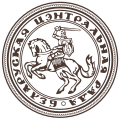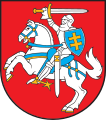Talk:Q668988
Autodescription — Pahonia (Q668988)
- Useful links:
- View it! – Images depicting the item on Commons
- Report on constraint conformation of “Pahonia” claims and statements. Constraints report for items data
- See also
- This documentation is generated using
{{Item documentation}}.
«The coat of arms of Lithuania: the Grand Duchy of Lithuania and the Republic of Lithuania» is a totally inaccurate statement and should be removed. There are no reliable sources were provided that Lietuva (modern Lithuania) is the same with the Grand Duchy of Lithuania (historical Lithuania). On the other hand, Andrew Wilson, a British historian specializing in Eastern Europe, writes in his book Belarus: The Last European Dictatorship (Yale University Press, 2012): The entity referred to as medieval ‘Lithuania’ in fact had the full name of ‘Grand Duchy of Lithuania, Rus and Samogitia’. Its short name was ‘Litva’. This is not the same thing as ‘Lithuania’. In the modern Lithuanian language, the word for ‘Lithuania’ is Lietuva (p. 21—22). <...> Most of what is now Belarus was part of ‘Litva’ proper. (p. 33). Moreover, another historian specializing in the history of Central and Eastern Europe Dr. Prof. Timothy D. Snyder writes in his book The Reconstruction of Nations: Poland, Ukraine, Lithuania, Belarus, 1569-1999 (Yale University Press, 2003): During the period of dynastic union with Poland, Lithuania became an East Slavic realm in which the gentry enjoyed rights relative to the sovereign (p. 22). Before 1863, the most common self-appellation of the largest group in Russia’s Northwest Territory — Belarusian-speaking peasants — was apparently “Lithuanian” (p. 49). By removing the historical sense of the term “Lithuanian” in the popular mind, Russian power cleared the way for a modern, ethnic definition of Lithuania, and simplified the task of Lithuanian activists (p. 50). <...> The conflation of an old politonym with a new ethnonym (“Lithuania”) prevented non-Belarusians from seeing the connection between modern Belarus and the early modern Grand Duchy of Lithuania (p. 81) <...> As we have seen, the traditions of the Grand Duchy were altered beyond recognition by Lithuanian and Polish national movements, as well as Russian imperial and Soviet states. They have changed least perhaps in the lands we now call Belarus (p. 281). --Kazimier Lachnovič (talk) 22:39, 18 November 2021 (UTC)
- More reliable sources against nationalistic (chauvinistic) vandalism with stating that the meaning of term "Lithuania" was the same in the past.
- In the Historical dictionary of Belarus (a part of Historical Dictionaries series) an American historian of Belarusan descent Dr. Jan Zaprudnik (1998 edition) states: «In some cases the entire area of contemporary Belarus was referred to as Litva (Lithuania), because it had been part of the territorial core of the Grand Duchy of Lithuania, and the Belarusians were known as lićviny, litovtsy, litvaki, litwaks». (p. 31) <...> «Belarusian historians stress the economic potential of Belarus within the GDL and the state's cultural aspects, that is, the fact that Belarusian was the official language of the duchy and that Belarusian culture flourished in it, especially during the 16th century <...> One should also keep in mind the terminological specifity: the meaning of such terms as “Rus”, “Belarus”, and “Litva” (Lithuania) were quite different in past centuries from today» (p. 139).
- Welsh-Polish historian with special interest in Central and Eastern Europe Dr. Prof. Norman Davies, Professor at the Jagiellonian University, professor emeritus at University College London, a visiting professor at the Collège d'Europe, and an honorary fellow at St Antony's College, Oxford, writes in Litva: The Rise and Fall of the Grand Duchy of Lithuania (2013): «In its modern spelling, written as Lietuva, it is the modern Lithuanian name for Lithuania. According to scholars of the Belarusian persuasion, however, Litva was originally the homeland of a Slavic tribe, and had no connection with the Balts until the Balts moved south, absorbed the Slavic tribe and purloined its name» <...> «The Metryka Litevska or ‘Lithuanian Register’ is the commonest collective name for the original indexes/archival inventories of the grand duchy’s central chancery. <...> The principal languages employed are ruski (Old Belarusian), Latin and Polish».
- Canadian historian Dr. Prof. David R. Marples, Distinguished University Professor at the Department of History & Classics at the University of Alberta, who specializes in history and contemporary politics of Belarus, Russia and Ukraine, writes in Belarus: A Denationalized Nation (2013, Routledge): «Belarusian territory became a part of the Grand Duchy of Lithuania with the capital at Vilna (Vilnius), a state in which Slavs heavily outnumbered the Lithuanians, retaining privileges, and in which state business was conducted in the Belarusian language». (p. 1).
- Quote from Ethnic Groups of Europe: An Encyclopedia (2011, ABC-Clio) by American anthropologist Dr. Prof. Jeffrey Cole, who is an expert on race and ethnicity in Europe, and Dr. Prof. Stephan E. Nikolov, a Senior Fellow researcher at the Bulgarian Academy of Science, Institute of Sociology and Associated Professor at the Neofit Rilski Southwestern University Blagoevgrad: «During the Middle Ages Belarusians were identified as Rusyns or Ruthenians as well as “Litviny” (Litvins, or Lithuanians). This later term refers to the state of the Grand Duchy of Lithuania (Litva, Great Litva), part of which was White Ruthenian lands after the 13th to 14th centuries. The Ruthenian language, which later evolved into modern Belarusian, was the official language there. For this reason many historians argue that the medieval Grand Duchy of Lithuania was the first Belarusian nation state». (p. 43).
- --Kazimier Lachnovič (talk) 21:21, 6 December 2021 (UTC)

Pahonia (Pogonia, Pogoń) is the coat of arms of the Grand Duchy of Lithuania.
Armorial of Kasper Niesiecki "Korona Polska", p. 30:
Zowie się ten herb Pogonią, podobno od konia, niby aby w pogoń zaciekłego.
translate.google.com:
This coat of arms is called Pogonia (Pahonia), apparently from a horse, as if in pursuit of the fierce.
The coat of arms of Pahonia (Pogonia) was created in the 14-15th centuries. The coat of arms of the Republic of Lithuania (Vytis) was created after 1918.
-
Belarus, 1918
-
Belarus, 1918
-
Belarusian Central Council, 1943
-
Belarus, 1991–1995
-
Lithuania, Vytis 1940
-
Lithuania, Vytis 1990-1991
-
Lithuania, Vytis 1991
On the basis of the coat of arms of Pogoniai, the coats of arms of the Belarusian People's Republic (1918), the Republic of Lithuania (1918), the Republic of Belarus (1991-1995), Lithuania (1990, 1991) were created. --Лобачев Владимир (talk) 09:32, 9 December 2021 (UTC)
- In addition to the provided quotes from several contemporary specialized reliable sources there are some very related quotes from The Rise and Fall of Belarusian Nationalism, 1906–1931 (2015, University of Pittsburgh Press) by Swedish-American historian Dr. Prof. Per Anders Rudling, specializing in the areas of nationalism: „Lithuania — or Letuva, Litva, Litwa, Lietuva, or Lite, as it was called in the five local languages — was commonly not thought of in the same terms as it is today, as an ethnic nation-state of the Lithuanian people. <...> In the early nineteenth century, “Belarusian” or “Lithuanian” did not yet denote any particular ethnic belonging. <...> As a state symbol, the BNR adopted the Pahonia, "the chase", a stylized image of an armed knight on a white stallion against a red background. This symbol had deep roots, going back to the fourteenth century. <...> ...the Pahonia was nearly identical to the coat of arms of the newly proclaimed Lithuanian state; <...> The Belarusian People's Republic had established a three-band white-red-white flag, and a modified version of the coat of arms of the Grand Duchy of Lithuania.“ --Kazimier Lachnovič (talk) 19:19, 15 December 2021 (UTC)
First coat of arms[edit]
-
First coat of arms. 1330
@Dragovit: Why the first image of the Pahonia coat of arms was removed? --Лобачев Владимир (talk) 12:56, 13 April 2022 (UTC)







